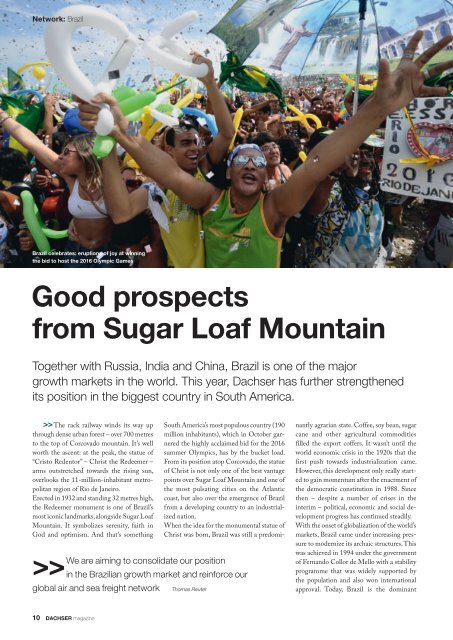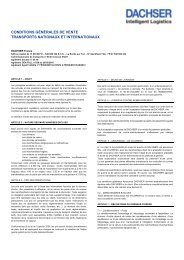You also want an ePaper? Increase the reach of your titles
YUMPU automatically turns print PDFs into web optimized ePapers that Google loves.
Network: Brazil<br />
Brazil celebrates: eruptions of joy at winning<br />
the bid to host the 2016 Olympic Games<br />
Good prospects<br />
from Sugar Loaf Mountain<br />
Together with Russia, India and China, Brazil is one of the major<br />
growth markets in the world. This year, <strong>Dachser</strong> has further strengthened<br />
its position in the biggest country in South America.<br />
>> The rack railway winds its way up<br />
through dense urban forest – over 700 metres<br />
to the top of <strong>Co</strong>rcovado mountain. It’s well<br />
worth the ascent: at the peak, the statue of<br />
“Cristo Redentor” – Christ the Redeemer –<br />
arms outstretched towards the rising sun,<br />
overlooks the 11-million-inhabitant metropolitan<br />
region of Rio de Janeiro.<br />
Erected in 1932 and standing 32 metres high,<br />
the Redeemer monument is one of Brazil’s<br />
most iconic landmarks, alongside Sugar Loaf<br />
Mountain. It symbolizes serenity, faith in<br />
God and optimism. And that’s something<br />
10 DACHSER magazine<br />
South America’s most populous country (190<br />
million inhabitants), which in October garnered<br />
the highly acclaimed bid for the 2016<br />
summer Olympics, has by the bucket load.<br />
From its position atop <strong>Co</strong>rcovado, the statue<br />
of Christ is not only one of the best vantage<br />
points over Sugar Loaf Mountain and one of<br />
the most pulsating cities on the Atlantic<br />
coast, but also over the emergence of Brazil<br />
from a developing country to an industrialized<br />
nation.<br />
When the idea for the monumental statue of<br />
Christ was born, Brazil was still a predomi-<br />
>><br />
We are aiming to consolidate our position<br />
in the Brazilian growth market and reinforce our<br />
global air and sea freight network Thomas Reuter<br />
nantly agrarian state. <strong>Co</strong>ffee, soy bean, sugar<br />
cane and other agricultural commodities<br />
filled the export coffers. It wasn’t until the<br />
world economic crisis in the 1920s that the<br />
first push towards industrialization came.<br />
However, this development only really started<br />
to gain momentum after the enactment of<br />
the democratic constitution in 1988. Since<br />
then – despite a number of crises in the<br />
interim – political, economic and social development<br />
progress has continued steadily.<br />
With the onset of globalization of the world’s<br />
markets, Brazil came <strong>und</strong>er increasing pressure<br />
to modernize its archaic structures. This<br />
was achieved in 1994 <strong>und</strong>er the government<br />
of Fernando <strong>Co</strong>llor de Mello with a stability<br />
programme that was widely supported by<br />
the population and also won international<br />
approval. Today, Brazil is the dominant




